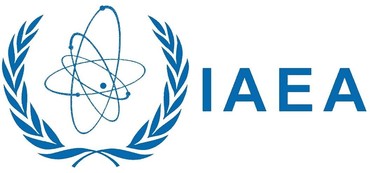7.1: Sharing and Monitoring Nuclear Technology
- Page ID
- 95970
\( \newcommand{\vecs}[1]{\overset { \scriptstyle \rightharpoonup} {\mathbf{#1}} } \)
\( \newcommand{\vecd}[1]{\overset{-\!-\!\rightharpoonup}{\vphantom{a}\smash {#1}}} \)
\( \newcommand{\id}{\mathrm{id}}\) \( \newcommand{\Span}{\mathrm{span}}\)
( \newcommand{\kernel}{\mathrm{null}\,}\) \( \newcommand{\range}{\mathrm{range}\,}\)
\( \newcommand{\RealPart}{\mathrm{Re}}\) \( \newcommand{\ImaginaryPart}{\mathrm{Im}}\)
\( \newcommand{\Argument}{\mathrm{Arg}}\) \( \newcommand{\norm}[1]{\| #1 \|}\)
\( \newcommand{\inner}[2]{\langle #1, #2 \rangle}\)
\( \newcommand{\Span}{\mathrm{span}}\)
\( \newcommand{\id}{\mathrm{id}}\)
\( \newcommand{\Span}{\mathrm{span}}\)
\( \newcommand{\kernel}{\mathrm{null}\,}\)
\( \newcommand{\range}{\mathrm{range}\,}\)
\( \newcommand{\RealPart}{\mathrm{Re}}\)
\( \newcommand{\ImaginaryPart}{\mathrm{Im}}\)
\( \newcommand{\Argument}{\mathrm{Arg}}\)
\( \newcommand{\norm}[1]{\| #1 \|}\)
\( \newcommand{\inner}[2]{\langle #1, #2 \rangle}\)
\( \newcommand{\Span}{\mathrm{span}}\) \( \newcommand{\AA}{\unicode[.8,0]{x212B}}\)
\( \newcommand{\vectorA}[1]{\vec{#1}} % arrow\)
\( \newcommand{\vectorAt}[1]{\vec{\text{#1}}} % arrow\)
\( \newcommand{\vectorB}[1]{\overset { \scriptstyle \rightharpoonup} {\mathbf{#1}} } \)
\( \newcommand{\vectorC}[1]{\textbf{#1}} \)
\( \newcommand{\vectorD}[1]{\overrightarrow{#1}} \)
\( \newcommand{\vectorDt}[1]{\overrightarrow{\text{#1}}} \)
\( \newcommand{\vectE}[1]{\overset{-\!-\!\rightharpoonup}{\vphantom{a}\smash{\mathbf {#1}}}} \)
\( \newcommand{\vecs}[1]{\overset { \scriptstyle \rightharpoonup} {\mathbf{#1}} } \)
\( \newcommand{\vecd}[1]{\overset{-\!-\!\rightharpoonup}{\vphantom{a}\smash {#1}}} \)
\(\newcommand{\avec}{\mathbf a}\) \(\newcommand{\bvec}{\mathbf b}\) \(\newcommand{\cvec}{\mathbf c}\) \(\newcommand{\dvec}{\mathbf d}\) \(\newcommand{\dtil}{\widetilde{\mathbf d}}\) \(\newcommand{\evec}{\mathbf e}\) \(\newcommand{\fvec}{\mathbf f}\) \(\newcommand{\nvec}{\mathbf n}\) \(\newcommand{\pvec}{\mathbf p}\) \(\newcommand{\qvec}{\mathbf q}\) \(\newcommand{\svec}{\mathbf s}\) \(\newcommand{\tvec}{\mathbf t}\) \(\newcommand{\uvec}{\mathbf u}\) \(\newcommand{\vvec}{\mathbf v}\) \(\newcommand{\wvec}{\mathbf w}\) \(\newcommand{\xvec}{\mathbf x}\) \(\newcommand{\yvec}{\mathbf y}\) \(\newcommand{\zvec}{\mathbf z}\) \(\newcommand{\rvec}{\mathbf r}\) \(\newcommand{\mvec}{\mathbf m}\) \(\newcommand{\zerovec}{\mathbf 0}\) \(\newcommand{\onevec}{\mathbf 1}\) \(\newcommand{\real}{\mathbb R}\) \(\newcommand{\twovec}[2]{\left[\begin{array}{r}#1 \\ #2 \end{array}\right]}\) \(\newcommand{\ctwovec}[2]{\left[\begin{array}{c}#1 \\ #2 \end{array}\right]}\) \(\newcommand{\threevec}[3]{\left[\begin{array}{r}#1 \\ #2 \\ #3 \end{array}\right]}\) \(\newcommand{\cthreevec}[3]{\left[\begin{array}{c}#1 \\ #2 \\ #3 \end{array}\right]}\) \(\newcommand{\fourvec}[4]{\left[\begin{array}{r}#1 \\ #2 \\ #3 \\ #4 \end{array}\right]}\) \(\newcommand{\cfourvec}[4]{\left[\begin{array}{c}#1 \\ #2 \\ #3 \\ #4 \end{array}\right]}\) \(\newcommand{\fivevec}[5]{\left[\begin{array}{r}#1 \\ #2 \\ #3 \\ #4 \\ #5 \\ \end{array}\right]}\) \(\newcommand{\cfivevec}[5]{\left[\begin{array}{c}#1 \\ #2 \\ #3 \\ #4 \\ #5 \\ \end{array}\right]}\) \(\newcommand{\mattwo}[4]{\left[\begin{array}{rr}#1 \amp #2 \\ #3 \amp #4 \\ \end{array}\right]}\) \(\newcommand{\laspan}[1]{\text{Span}\{#1\}}\) \(\newcommand{\bcal}{\cal B}\) \(\newcommand{\ccal}{\cal C}\) \(\newcommand{\scal}{\cal S}\) \(\newcommand{\wcal}{\cal W}\) \(\newcommand{\ecal}{\cal E}\) \(\newcommand{\coords}[2]{\left\{#1\right\}_{#2}}\) \(\newcommand{\gray}[1]{\color{gray}{#1}}\) \(\newcommand{\lgray}[1]{\color{lightgray}{#1}}\) \(\newcommand{\rank}{\operatorname{rank}}\) \(\newcommand{\row}{\text{Row}}\) \(\newcommand{\col}{\text{Col}}\) \(\renewcommand{\row}{\text{Row}}\) \(\newcommand{\nul}{\text{Nul}}\) \(\newcommand{\var}{\text{Var}}\) \(\newcommand{\corr}{\text{corr}}\) \(\newcommand{\len}[1]{\left|#1\right|}\) \(\newcommand{\bbar}{\overline{\bvec}}\) \(\newcommand{\bhat}{\widehat{\bvec}}\) \(\newcommand{\bperp}{\bvec^\perp}\) \(\newcommand{\xhat}{\widehat{\xvec}}\) \(\newcommand{\vhat}{\widehat{\vvec}}\) \(\newcommand{\uhat}{\widehat{\uvec}}\) \(\newcommand{\what}{\widehat{\wvec}}\) \(\newcommand{\Sighat}{\widehat{\Sigma}}\) \(\newcommand{\lt}{<}\) \(\newcommand{\gt}{>}\) \(\newcommand{\amp}{&}\) \(\definecolor{fillinmathshade}{gray}{0.9}\)Atoms For Peace Speech
On December 8, 1953, President Dwight D. Eisenhower addressed the United Nations with a twenty-minute speech entitled, " Atoms for Peace." In this event, Eisenhower attempted to diminish the nuclear arms race between the United States and the Soviet Union. Eisenhower believed that peaceful uses of nuclear technology should be available to all countries. Moreover, he encouraged non-nuclear states (countries) to obtain information regarding advances in nuclear medicine and nuclear reactors. The United States and the Soviet Union would no longer have a monopoly on nuclear applications. President Eisenhower wanted a central agency that would collect, store, and distribute radioactive materials to all countries. This "uranium bank" would allow non-nuclear states to obtain fissionable material for medicine and energy. Watch the video below to gain more insight into the "Atoms for Peace" speech.
IAEA
In response to Eisenhower's speech, the United Nations established the IAEA (International Atomic Energy Agency) in 1957. This group serves as the world's nuclear watchdog and has three goals to oversee:
- Assist all member countries with peaceful uses of nuclear technology
- Inspect nuclear facilities to ensure weapons are not being constructed
- Provide information regarding the safety of nuclear materials.
The IAEA is housed in Vienna, Austria. It has two regional offices in Toronto, Canada, and Tokyo, Japan. There are liaison offices for this organization in New York City and Geneva, Switzerland. Research facilities for the IAEA are located in Austria and Monaco. As of March 2022, there were 175 member countries of the IAEA. A listing of these countries with their dates of membership can be found by clicking on this link. On this list, North Korea has been removed from membership. This can be attributed to their lack of cooperation regarding reactor inspections.

Image is taken from upload.wikimedia.org/wikiped...AEA_emblem.jpg
NPT
The IAEA has also been charged with enforcing the NPT (Nuclear Non-Proliferation Treaty). Entered into force in March of 1970, this involves nuclear and non-nuclear states. Nuclear states are the five countries that exploded a nuclear device before 1967. This group includes the United States, Russia, United Kingdom, France, and China. All other countries besides these are labeled as being non-nuclear states. The five nuclear states and the IAEA are responsible for enforcing the NPT. This treaty expects the following to occur:
- States that do not have nuclear weapons will not build or buy them.
- States that possess nuclear weapons will work towards disarmament.
- All states will be provided information regarding peaceful applications of nuclear technology.
As ofNovember 2022 , there were 191 countries that had signed the NPT. This link shows countries and their NPT statues. Many countries have ratified or consent to abide by this document. Others have assessed the treaty which means they have accepted NPT terms after the treaty has been entered into force. Lastly, some countries have succeeded or revoked membership from the NPT. For a basic overview of the NPT, click on the video below.
Strategic Arms Reduction Treaty (START)
On July 31, 1991, the United States and the Russian Federation signed the Strategic Arms Reduction Treaty (START). Since the Soviet Union dissolved in December 1991, the enforcement date of this treaty was postponed to December of 1994. This treaty limits number of Intercontinental Ballistic Missiles (ICBM) and nuclear warheads that both of these countries possess. Both Russia and the United States agreed to inspections and reductions of their strategic nuclear stockpiles.
References
Contributors and Attributions
- Caralyn Zehnder et al. at Georgia College and State University

